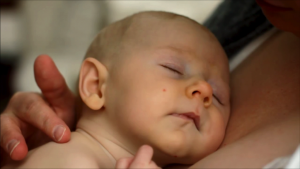When your baby is newborn, her tummy is about the size of a small marble, which is tiny. So it will fill up quickly but empty quickly too. So the feeds should be little and often. Don’t worry if it doesn’t feel like it takes long for her to become full. It’s also important to remember that breastfeeding isn’t just about milk. She may be on the breast for comfort too or stay on after she’s no longer hungry. If you aren’t in discomfort or don’t need to do anything else urgently, enjoy the fact that breastfeeding isn’t all about milk delivery and let her stay on when she wants to be there.

Let her guide you in the early days as to how much time on the breast she needs. It might feel really frequent, but that’s OK. Tiny feeds very frequently help give your body signals to make milk, so it all works as a system. Your baby’s nappies will let you know how things are going.
After a week or 2, you’ll start to get more of an idea of how long your baby needs to feed to be full. However babies don’t just feed for hunger and if you respond to your baby’s feeding and behavior cues you will find that she sometimes has a small feed, sometimes a large one and sometimes it can seem like she is just playing around. If you try to relax and go with your baby she will settle and all the early feedings will result in a better long-term milk supply for you. New babies are not designed to be left by themselves as they have been used to being inside you 24/7. You really are their world and if you are responsive to your baby in these early weeks it will help them feel safe and secure as well as getting all they need in terms of nutrition.
Feeding cues that she’s hungry include:
After a week or 2 as well, your baby will probably fall into a pattern of wanting to feed only once every 2-3 hours but there may be times in the day when they want to feed more frequently than this or in a longer block. All babies are different; some will want to feed for longer at the breast, and then last longer between feeds. They’re all different and milk production patterns vary from mother to mother and from feed to feed.
Don’t worry too much about ‘foremilk’ and ‘hindmilk’. These terms were used in the past to help mums understand that towards the middle and end of a feed their milk is full of good fats and calories but it doesn’t mean your body makes 2 different types of milk – the transition to fattier milk is gradual.
It is important to give your baby time to have a full feed from a breast when they want to so they have the opportunity to get to the fattier milk. To help baby reach the fatty milk, don’t swap breasts mid-feed unless your baby shows they want to. Stay on one breast until your baby comes off because the breast has been effectively nursed. If your baby is still hungry, you can go on to feed on the other breast as well, but make sure the baby has had a good feed from the first breast. You can tell if your baby gets down to the fat rich ‘hindmilk’ by getting familiar with her sucking patterns. They’re long and deeper for the thinner ‘foremilk’ that comes right at the beginning of a feed, and they get shorter, more fluttery (harder work sucking) for the thicker hindmilk.
Be guided by your baby.
It’s important to remember that babies don’t always take full feeds and don’t always want or need to get to the fattier milk. Sometimes they want a drink, sometimes a nuzzle and few mouth fulls. Your baby may have around 8 full feeds but there still will be other snacking taking place. ‘Snacking’ (or much shorter feeds) aren’t always a bad thing. Your baby might just be looking for a drink just as we do and doesn’t want a whole meal.
You’ll know the balance is right if baby’s nappies and weight gain are meeting expectations.
When your baby is having a growth spurt, which might happen at any time in the first 10-15 days (or beyond that), lots of Mums worry they don’t have enough milk. Don’t worry, as your baby feeds longer and more frequently, the feedback loops will send messages to your body to make more milk, so it will soon catch up.
Simple checks your baby is getting enough milk include: